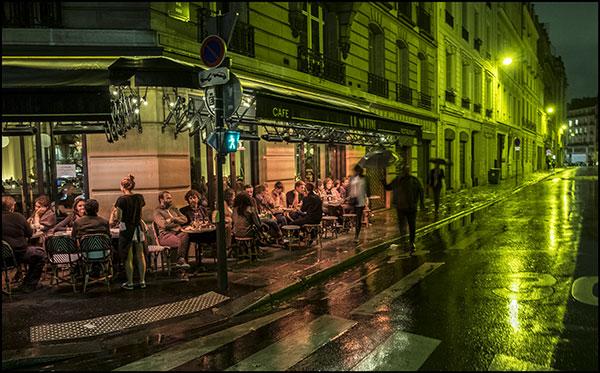Truer Colors: How a Travel Photographer Captured the Mood of Paris By Night

There was something about the lights, the wet streets, and the look of the café that Bill Durrence and his wife, Barbara, passed on their way back to the hotel that rainy night in Paris last September. He took this picture to capture the feeling of that moment, but the scene’s mixed lighting and his camera’s white balance weren’t in sync with his intent.
“I had the white balance set for cloudy, and the look of the photo was way too warm,” Durrence says. “The area that’s now green was kind of yellowish, and the pink area was orangey.”
Later he worked the Raw file back to the emotional response he felt at the time. “I started by neutralizing the color imbalance in the café, reducing the warmth—especially in the flesh tones—back to natural, to more realistic. But I did that globally, so the yellow tone was reduced. I liked the green that resulted and the overall look of the photo.”
He’s not alone. “I’ve had so much positive feedback about this image. There’s something about the colors that communicates the feel of that rainy night.”
The feel of a photo is something he’s thought about often throughout his career. “A lot of people get very purist about it—the picture is what comes out of the camera,” he says. “I came out of journalism and understand the strictures: if you’re doing something that purports to be factual, you have to be judicious in whatever editing you do. Burning, dodging, color correcting—you always manipulated to some extent, mostly trying for some degree of accuracy, but if you’re not in the mode of evidentiary presentation of a scene, you can do anything you want to get the feeling out of the picture that you want.”
It’s a message he delivered during 22 years as an instructor for the Nikon School of Photography, as well as at workshops and photo treks. “If I were teaching this photo, I’d say right out front that it’s not a representation of the way it looked, but the way it felt.”
When I asked him if sometimes he’d adjust a photo to be the best representation of the spirit of the moment, Durrence responded, “I don’t know if I’d even put in the ‘sometimes.’ When there’s no requirement to be documentary or factual about a photo, my work is tilted toward the emotional content I can pull out of the scene. I always encourage people to work the picture to get to the emotion.”
Information about Bill Durrence’s educational programs is available at billdurrence.com.
Tech Talk: Bill Durrence took the photo with a Fuji X-T1 and an XF 18-55mm f/2.8-4 R LM OIS lens. The settings were 1/2 second, f/8, ISO 1600, aperture priority, and Multi metering.

















































